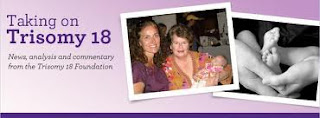What Is Trisomy 18?
Trisomy 18, also known as Edwards syndrome, is a condition which is caused by a error in cell division, known as meiotic disjunction. Trisomy 18 occurs in about 1 out of every 2500 pregnancies in the United States, about 1 in 6000 live births. The numbers of total births increase significantly when stillbirths are factored in that occur in the 2nd and 3rd trimesters of pregnancy.
Unlike Down syndrome, which also is caused by a chromosomal defect, the developmental issues caused by Trisomy 18 are associated with medical complications that are more potentially life-threatening in the early months and years of life. 50% of babies who are carried to term will be stillborn, with baby boys having higher stillbirth rate than baby girls.
At birth, intensive care admissions in Neonatal units are most common for infants with Trisomy 18. Again, baby boys will experience higher mortality rates in this neonatal period than baby girls, although those with higher birth weights do better across all categories.
Some children will be able to be discharged from the hospital with home nursing support for their families. And although less than 10 percent survive to their first birthdays, some children with Trisomy 18 can enjoy many years of life with their families, reaching milestones and being involved with their community. A small number of adults (usually girls) with Trisomy 18 have and are living into their twenties and thirties, although with significant developmental delays that do not allow them to live independantly without assisted caregiving.
Frequently Asked Questions
At conception, 23 chromosomes from the father and 23 chromosomes from the mother combine to create a baby with a set of 46 chromosomes in each cell. A trisomy occurs when a baby has three #18 chromosomes instead of the normal two. This is something that happens at conception. And although many parents worry about this, it is important to know that parents have done nothing before or during pregnancy to cause this disorder in their child.
Are there different types of Trisomy conditions?
The most common trisomy is Trisomy 21, also known as Down syndrome, where a baby has three of the twenty-first chromosome. Trisomy 18 is the second most common trisomy and occurs when a baby has three of the eighteenth chromosome. This results in 47 chromosomes instead of the normal 46 in the affected cells. It is this extra genetic material that causes the problems associated with Trisomy 18. The third most common is Trisomy 13, also known as Patau syndrome.
While there are different types of Trisomy 18, this does not mean one is better for a child than another. With each type, there is a range of possibilities. Some children are medically fragile while others thrive; some children walk while others are confined to wheelchairs. It is hard to say how the extra chromosome will impact an individual child from the genetic diagnosis alone.
Types of Trisomy 18:
- Full Trisomy 18: The most common type of Trisomy 18 (occurring in about 95% of all cases) is full Trisomy. With full Trisomy, the extra chromosome occurs in every cell in the baby's body. This type of trisomy is not hereditary. It is not due to anything the parents did or did not do—either before or during pregnancy.
- Partial Trisomy 18: Partial trisomies are very rare. They occur when only part of an extra chromosome is present. Some partial Trisomy 18 syndromes may be caused by hereditary factors. Very rarely, a piece of chromosome 18 becomes attached to another chromosome before or after conception. Affected people have two copies of chromosome 18, plus a "partial" piece of extra material from chromosome 18.
- Mosaic Trisomy 18: Mosaic trisomy is also very rare. It occurs when the extra chromosome is present in some (but not all) of the cells of the body. Like full Trisomy 18, mosaic Trisomy is not inherited and is a random occurrence that takes place during cell division.
The genetic material from the extra eighteenth chromosome can cause a variety of problems with varying severity. Just as children with Down syndrome can range from mildly to severely affected, the same is true for children with Trisomy 18. This means that there is no hard and fast rule about what Trisomy 18 will mean for your child. However, statistics show that there is a high mortality rate for children with Trisomy 18 before or shortly after birth.
Typical characteristics of Trisomy 18 include:
- Heart defects:
- VSD (Ventricular Septal Defect): a hole between the lower chambers
- ASD (Atrial Septal Defect): a hole between the upper chambers
- Coarctation of the aorta: a narrowing of the exit vessel from the heart
- Kidney problems
- Part of the intestinal tract is outside the stomach (omphalocele)
- The esophagus doesn’t connect to the stomach (esophageal artesia)
- Excess amniotic fluid (polyhydramnios)
- Clenched hands
- Pocket of fluid on the brain (choroid plexus cysts)
- Rocker bottom feet
- Delayed growth
- Small jaw (mycrognathia)
- Small head (microcephaly)
- Low-set ears
- Strawberry-shaped head
- Severe developmental delays
- Umbilical or inguinal hernia

No comments:
Post a Comment
Note: Only a member of this blog may post a comment.